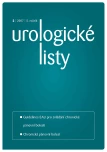POSTOPERATIVE PAIN
Authors:
P. Ševčík; I. Křikava
Authors‘ workplace:
Klinika anesteziologie, resuscitace a intenzivní medicíny LF MU a FN Brno
Published in:
Urol List 2007; 5(2): 5-13
Overview
Postoperative pain is a typical example of acute pain both from the pathophysiological and therapeutic point of view. Its intensity, quality and duration depend on a number of factors associated with the surgery as such, as well as pre-surgical preparation and, in the first place, post-operative care. Quality post-operative analgesia demonstrably reduces both post-operative morbidity and the length of hospitalisation. Post-operative pain can be alleviated by systemic and regional procedures. Non-opioid analgesics (especially paracetamol and metamizol, or non-steroidal analgesics - antiphlogistics), opioids and combinations of analgesics of both the groups are used. Preparations from other drug groups can also be used. Analgesics can be administered per os, per rectum, intravenously, subcutaneously; local anaesthetics (or opioids) can be applied regionally - to the area of nervous structures or the spinal channel. Currently, we have a wide range of analgesic preparations and procedures. Of greatest importance, today, is the control of post-operative pain management in particular health centres.
Key words:
opioids, non-opioid analgesics, non-steroidal analgesics - antiphlogistics, patient-controlled analgesia, post-operative analgesia
Sources
1. Attard AR, Corlett MJ, Kinder NJ et al. Safety of early pain relief for acute abdominal pain. BMJ 1992; 305: 554-559.
2. Beubler E, Kress H-G et al. Konsensus-Statement. Postoperative Schmerztherapie. Schmerz Nachrichten 2003; 4: 2-11.
3. Baier MB, Schul SA. Safety aspects of postoperative pain relief. Pain Digest 1996; 6: 219-225.
4. Berchtold R, Hamelmann H, Peiper H-J et al. Perioperative Schmerztherapie. In: Chirurgie. München, Jena: Urban & Fischer 1999: 155-159.
5. Breivik H. High-tech versus low-tech approaches to postoperative pain control. Abstracts. 9th World Congress on Pain, Vienna. Seattle: IASP Press 1999: 376.
6. čumlivski R, Redl G. Stellenwert der patientenkontrollierten Analgesie bei postoperativen Schmerzen. Acta Chir Austriaca 2001; 2: 33.
7. Calcey TH, Wiliams NE. Principles and Practice of Pharmacology for Anaesthetists, Analgesic Drugs. 3. ed. Cambridge: Blackwell Science 1997: 362-413.
8. Denson DD, Katz JA. Nonsteroidal antiinflamatory agents. In: Raj PP. Practical management of pain. 2. ed. St. Luis: Mosby Year Book 1993: 606-617.
9. Di Fazio C, Wildsmith JAW. Naropin. Monografie. Praha: Astra Pharmaceuticals 1999: 47.
10. Erdine S. Organization of an acute postoperative analgesia team: A long-term survey of 2500 patients. In: Van Zundert A (ed). Highlits in Regional Anaesthesia and Pain Therapy IV. Barcelona: ESRA and Publicidad Permanyer, S. L. 1995: 39-50.
11. Ferrante FM. Organization of an acute pain service. The american perspective. In: Raj PP, Erdine S, Niv D, Raja S (eds). Management of Pain - a World Perspective. Bologna: Monduzzi Editore 1995: 45-47.
12. Freye E. Opioid agonists, antagonists and mixed narcotic analgesics. Berlin: Springer Verlag 1987: 108.
13. Heck M, Fresenius M. Repetitorium Anaesthesiologie. 2. ed. Berlin: Springer Verlag 1999: 484-485.
14. Hess L. Alfa-2 agonisté. Praha: Boehringer Ingelheim 1996: 36.
15. Hess L. Sufentanil v anesteziologii a intenzivní péči. Praha: Janssen-Cilag 1996: 29.
16. Jage J, Hartje H. Postoperative Schmerztherapie. Teil 1. Anaesthesist 1997; 46: 65-77.
17. Jage J, Hartje H. Postoperative Schmerztherapie. Teil 2. Anaesthesist 1997; 46: 161-173.
18. Jöhr M. Kinderanästhesie. 5. ed. Stuttgart: Gustav Fischer Verlag 2001: 86.
19. Larsen R. Anestezie. 7. ed. Praha: Grada Publishing 2004: 797-799.
20. Ogilvy AJ, Smith G. Postoperative Pain. In: Nimmo WS, Rowbotham DJ, Smith G (eds). Anaesthesia. 2. ed. Oxford: Blackwell Sceintific Publications 1994; 2. vol: 1570-1601.
21. Opavský J. Stručný přehled farmakoterapie bolesti. Praha: Remedia 1995; 5: 71-81.
22. Pace S, Burke TF. Intravenous morphine for early pain relief in patients with acute abdominal pain. Acad Emerg Med 1996; 3: 1086-1092.
23. Pasternak GW. Pharmacological mechanisms of opioid receptors. Clin Neuropharmacol 1993; 16: 1-18.
24. Practice guidelines for acute pain management in the perioperative setting - a report by the Anesthesiologists Task Force on Pain Management, Acute Pain Section. Anestesiology 1995; 82: 1071-1081.
25. Practice guidelines for acute pain management in the perioperative setting: an updated report by the Anesthesiologists Task Force on Acute Pain Management. Anestesiology 2004; 100: 1573-1581.
26. Rawal N. Organization of acute pain service, eruopean perspective. In: Raj PP, Erdine S, Niv D, Raja S (eds). Management of Pain – a World Perspective. Bologna: Monduzzi Editore 1995: 48-50.
27. Ready B. Acute postoperative pain. In: Miller RD (ed). Anesthesia. 4. ed. New York: Churchill Livingstone 1994; 2. vol: 2328-2344.
28. Ready LB, Edwards A. Léčba akutní bolesti. Mezinárodní společnost pro studium bolesti. Pardubice: Stapro 1994: 99.
29. Rosenzweig S, Mines D. Acute pain management. In: Harwood-Nuss A, Wolfson AB (eds). The Clinical Practice of Emergency Medicine. 3. ed. Philadelphia: Lippincott Wiliams & Wilkins 2001: 1747-1753.
30. Rowlingson JC. Acute postoperative pain management. IARS 2001 Review Course Lectures. IARS 2001: 78-85.
31. Schmidt RL, Slander AN, Katz J. Use and efficacy of low-dose ketamine in the management of acute postoperative pain: A review of current techniques and outcomes. Pain 1999; 82: 111-125.
32. Ševčík P. Léčba pooperační bolesti. In: Zazula R (ed). Intenzivní perioperační péče. Praha: Galén 2000: 67-81.
33. Ševčík P, Málek J, Vrba I. Akutní bolest. Bolest 2000; 3(suppl 1): 38-44.
34. Ševčík P, čumlivski R. Akutní bolest. In: Rokyta R, Kršiak M, Kozák J (eds). Bolest. Praha: Tigis 2006: 202-225.
35. Tryba M, Zenz M. Unterschiede zwischen akutem und chronischem Schmerz. In: Zenz M, Jurna M (eds). Lehrbuch der Schmerztherapie. Grundlagen, Theorie und Praxis für Aus- und Weiterbildung. Stuttgart: Wissenschaftliche Verlagsgesellschaft mbH 1993: 335-343.
36. Urquhat ML et al. Patient controlled analgesia: A comparison of intravenous and subcutaneous hydromorphone. Anesthesiology 1988; 69: 428-432.
Labels
Paediatric urologist UrologyArticle was published in
Urological Journal

2007 Issue 2
Most read in this issue
- CHRONIC PELVIC PAIN AND SEXUAL FUNCTIONS AS SEEN BY UROLOGIST AND ANATOMIST
- Chronic pain in interstitial cystitis
- PATHOPHYSIOLOGY OF PELVIC PAIN
- POSTOPERATIVE PAIN
